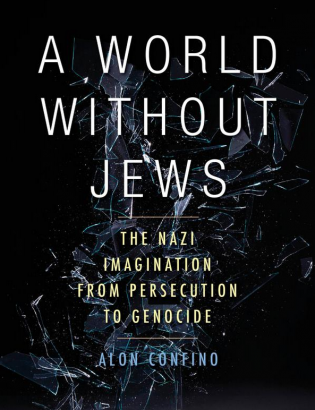Historian David Cesarani hails Alon Confino’s triumphant demonstration that anti-Jewish policies are within the realms of comprehension and that it is possible to find the words to explain them accessibly, two qualities we badly need today.
At a time when we are told that a ‘wave of anti-Semitism’ is sweeping Europe and that Jews face a threat comparable to the menace of the 1930s, it is good to be reminded of what Nazi anti-Semitism was like and what it was about. Alon Confino’s subtle and elegantly written study obliges us to confront the ways in which the Nazis imagined the Jews and the emotions which these fantasies stirred in the minds of ordinary German people. Confino boldly rejects the interpretations of Nazism that currently dominate scholarship, asserting that these offer a rather too comforting explanation. He argues that Nazi anti-Jewish policy cannot be reduced to racism, and certainly not to perverted scientific thinking. Rather, ideas of race and scientific practices were warped to provide the right answers to a pre-determined ‘Jewish question’. Nor did the persecution of the Jews represent a ‘radicalisation’ of anti-Semitism or metastasise due to the brutalisation of a regime and a people that were in a virtually constant state of imagined or real warfare. On the contrary, the Nazis drew on traditions of Jew-hatred and the violence they practiced evoked patterns which were rooted in the German past and in Christianity. Crucially, Confino situates Nazi anti-Semitism within the Christian tradition of anti-Judaism. Although many scholars (and theological apologists) have maintained that National Socialism was anti-religious, Confino states that, ’Their aim was not to eradicate Christianity but to eradicate Christianity’s Jewish roots; not to replace Christianity with racism but to blend the two.’
Confino’s combines analysis with a narrative of the Third Reich by examining a succession of instances that exemplify stages in the development of anti-Jewish policy. But he is less concerned with the detail of policies and plans than the ‘sensibilities and emotions’ that are implicit in them. He begins with the burning of books in May 1933. This symbolic auto da fe evoked the burning of sacred books and heretics in a bygone era, but gave it a contemporary relevance because the works and authors chosen for incineration represented ‘an evil modernity’. The writings of Marx, Freud, Einstein plus a list of Jewish and modernist writers stood for everything about the modern world that the Nazis and their supporters hated. For them ‘the Jew’ could embody everything from socialism to department stores, sexual liberation to atonal music. Unlike the political enemies of Nazism, who by May 1933 were already routed, the Jew remained dangerous. The Nazi students who were the driving force behind the bonfires proclaimed, ‘Our most dangerous opponent is the Jew and anyone who submits to him.’ Clearly this assault was of a different nature to routine politics, however brutally conducted. The festive atmosphere was intended to mark the liberation of the Germans from pernicious ideas, the purification by fire of the nation’s cultural life. At the same time, Jews endured a hail of state and local regulations designed to drive them out public life. Race was hardly mentioned in the accompanying preambles and rhetoric. Confino writes: ‘A national redemption, not a racial revolution, was on participants minds, to be celebrated within the traditions of German national festivals.’
Confino jogs through the early years of the Reich at a brisk pace and underplays the extent of confusion in Judenpolitik. For example, he barely mentions Hjalmar Schacht, the minister for the economy, who successfully insisted that the SA and SS stop harassing Jewish businesses. Schacht was no friend of the Jews, but his removal from office in 1937 opened the way to the total economic ruination of the Germans Jews. Surprisingly, Confino adopts an almost ‘intentionalist’ approach to Nazi policy making, somewhat replicating an earlier (and discredited) school of thought which insisted that Nazi policy tended inexorably towards the destruction of the Jews. His strength lies in the way he handles ideas and their interpretation.
In Confino’s persuasive analysis, race science was less important than telling a story about individual and national origins. By forcing Aryans to check on their ancestry before marrying or claiming benefits from the state, the Nazis constructed a sense of the past. They blended an exclusive identity based on blood and descent with the familiar identity based on place or Heimat. The process by which Aryan Germans traced their lineage back to towns and villages over a century ago simultaneously rendered the Jews rootless and cosmopolitan. The fact that Germans had to make use of church records – chronicling births, baptisms, marriages, and deaths – exposed the fallacy of racial science but conjoined a newfangled racial identity to a reassuringly familiar religious one. Furthermore, the Nazis reformulated the history of the nation and its regions in racial language. Rather than impose an entirely new identity on Germans they melded race with Heimat, the cosy notion of home as locality, region, and fatherland. They gave the Germans an eternal identity and juxtaposed this against a shifty, indeterminate ‘Jewish spirit’. Hence, the Nazi revolution was domesticated, clad in the symbols of continuity. And, according to Confino, it did indeed represent continuation rather than rupture.
Once the regime was consolidated, the Nazis stepped up their campaign to drive Jews out of Germany. They used religious holidays to stage anti-Semitic carnivals. They raised signs all over the country declaring ‘Jews not wanted here’ or boasting that a town was actually free of Jews. Intermittent violence staged in public places reinforced the message that the Jews had to go and symbolised the difference between those safely embraced by the Volk and those who were outcasts. The Nuremberg Laws were farcical as far as racial science was concerned, but they helped Germans tell a story about themselves and explained why Jews were being extruded. They were an alien Other, a source of contamination from whom the healthy German racial community had to be protected. But throughout the mid 1930s Jews were also targeted as the bearers of a despised religion: pro-Nazi Protestant churchmen set about de-Judaising the sacred books and liturgy of the Lutheran congregation. According to Confino, Germans were already imagining a Germany without Jews. The massive assault on the Jewish population of the Reich on 9-10 November 1938 (Kristallnacht) was not just intended to hasten its departure, as many historians have argued. It was an attempt to eradicate the Jews and Judaism. It was for this reason that the pogrom routinely featured the torching of synagogues, the desecration of Torah scrolls, and the ritual humiliation of Rabbis. On Kristallnacht ‘the Nazis created … a German national and Christian community that set out to liberate itself from the authority of Judaism.’ The anti-Jewish violence, the degradation, the contempt for religion was open and celebrated, although there is evidence that many Germans were alarmed at the destruction of property and some (especially Catholics) looked askance on the abuse of religion. Confino may be going too far when he states that ‘the new master race had been replacing the old chosen people,’ but he is surely correct to highlight this religious frenzy and counterbalance its neglect in previous accounts.
Confino is on less certain ground when he depicts the war as the Nazi effort to build a new empire and found an entirely new era of human history. While Hitler certainly wanted to eradicate Czechoslovakia and destroy Poland, the war he found himself fighting against France and Britain was not what he intended and the victories which gifted him an ‘empire’ astonished him as much as they did his vanquished foes. Confino is unduly impatient with the research that shows Nazi anti-Jewish policy in Poland and, later, across the sphere of German influence as haphazard and often self-contradictory. He rather airily asserts that when Hitler ‘prophesied’ the annihilation of the Jews on 30 January 1939, he intended their removal from German and Europe one way or another, and that the particularities of how this was to be achieved do not matter that much. However, the different experiences of a German Jew who managed to emigrate to Shanghai in mid-1941, before emigration was halted, and the fate of a Polish Jew starving to death in a sealed ghetto at the same time require explanation. He writes that, ‘The territorial solution [a Jewish reservation around Lublin, sending Jews to Madagascar or to Siberia] was always a fiction, a Nazi fable about getting rid of Jews.’ Yet this fiction was repeatedly translated into concrete policies and in terms of the possibilities for Jewish survival there were critical differences between the versions it took, if only at the margins.
Confino observes that the rituals of degradation which accompanied the slaughter of Jews in the occupied Soviet Union in 1941 closely resemble events in the Reich from 1933-1939, so should not be seen as anything new. He is right that German soldiers were habituated to anti-Jewish violence before the crusade against so-called Jewish-Bolshevism, but it is a big leap to conclude that there is also continuity from a Reich without a Jewish presence to a Nazi vision for a Europe denuded of Jews, heralding a new epoch. Confino wants us to believe that Hitler, Himmler and Goebbels transmuted a conventional war for colonial conquest and exploitation into one that sought ‘a cosmic result, either salvation or damnation.’ He suggests that behind the murderous activity of the Einsatzgruppen there was a visionary goal according to which ‘the Jewish world would be destroyed to make space for the Nazi one.’ The transition to genocide marked by the ‘Final Solution’ was intended to give meaning to the Nazi imperial enterprise. Extermination was ‘an act of creation.’ Well, maybe. His reading of speeches by Hitler, Himmler and Goebbels during 1941-1944 is certainly thought-provoking and he finds echoes of their words in the letters of ordinary soldiers and junior officers on the Eastern Front, bolstering the view that the troops shared Hitler’s millennial goals. However, the war was fought by conventional means and had a conventional outcome: economic and material superiority prevailed. In important ways the fate of the Jews was modulated by the course of the fighting. Germany’s chronic shortage of labour cut across the policies of mass murder, despite the rhetoric issuing from Berlin. The tussle over the survival of ghettos producing goods for the war effort suggests that not everyone bought into Hitler’s eschatological, anti-Semitic fantasy.
Nevertheless, Confino convincingly shows that the mass murder of Jews in ‘the East’ was well-known throughout Germany even if the details were blurry. He argues that Hitler publicly declaimed on the destruction of the Jews because it gave a rationale to the war, something that was especially important once the campaign turned into a prolonged struggle. ‘Jews gave the overall meaning to the Nazi fight between good and evil: the messianic struggle to create a Nazi civilization depended on the extermination of the Jews.’ In February 1942, the Führer even promised that once the war was over there would ensue ‘a long period of brotherhood among nations and a true peace’. Yet, according to Confino the Nazi leadership that ordered the mass murder of women and children, and the men who carried out or witnessed the slaughter, knew that they were engaged in a ‘transgressive’ act. So, while they openly bruited the ‘annihilation’ of the Jews, Hitler, Himmler and Goebbels had to use a coded language. Does this make sense given the importance that Confino ascribes to the millennial project of genocide? Is it really conceivable that if Hitler thought he was performing a messianic task by eradicating the Jews and Judaism he would fight shy of saying so in an unguarded fashion?
Confino displays a surer touch when he surveys German efforts to collect Judaica and sacred books from all over Europe in order to construct a Jewish museum which would relegate the Jews to an evil past that had been surmounted. Here traditional Christian supercessionism and modern racism commingled lethally. The Nazi vision of the future was coeval with the Christian one, with the difference that Christians would have preserved Jewish bodies while eviscerating the Jewish spirit. In neither future was there room for the Jews and Judaism.
It is this that differentiates Nazi anti-Semitism from other applications of Nazi racism. Non-European peoples, the severely disabled, homosexuals all faced discrimination and lethal measures at the hands of the Third Reich, but none were figured as a cosmic enemy that had to be extirpated for the sake of humanity. While Confino gestures towards fashionable theories which depict Nazi racism and empire building as one phase of European colonialism or equate it with Stalin’s genocidal policies, his argument and the evidence he adduces to support it all trend in another direction. Quoting astutely from Jewish witnesses at the time, such as Emmanuel Ringelblum, he shows how they ‘understood the Holocaust as a unique event beyond comprehension and words.’ Confino’s study is a triumphant demonstration that Nazi anti-Jewish policies are within the realms of comprehension and that it is possible to find the words to explain them accessibly and forcefully. But although he prefers to describe the Jewish fate was ‘an extreme version’ of genocidal thinking and practices in the 20th century, his conclusion jars with his own adumbration of the reasons why it was and continued to be ‘perceived as particular’. If anything his research will fortify the belief of those who prefer to see the Jewish catastrophe as ‘unique’.





































Thank you for this review of what is clearly an important book. In fact I would go so far as saying any author on the Holocaust that shies away from the role of Christianity, for whatever reason, self-censorship or willful ignorance, cannot be taken as seriously as the author would like it to be.
Given however the contemporary horror of anti-Semitism as anti-Israelism and as a ‘progressive’ force, I also think that any current author on the Holocaust cannot avoid mentioning the bridge between Nazi Jew-hatred and the present-day kind, even if only in an afterword or appendix. And yes the present-day secular anti-Semitism, as with Nazi anti-Semitism, has a Christian dynamic to it. Cesarani does not let us know whether Confino mentions present-day Western anti-Semitism, no matter how briefly, nor what Confino has to say on it.